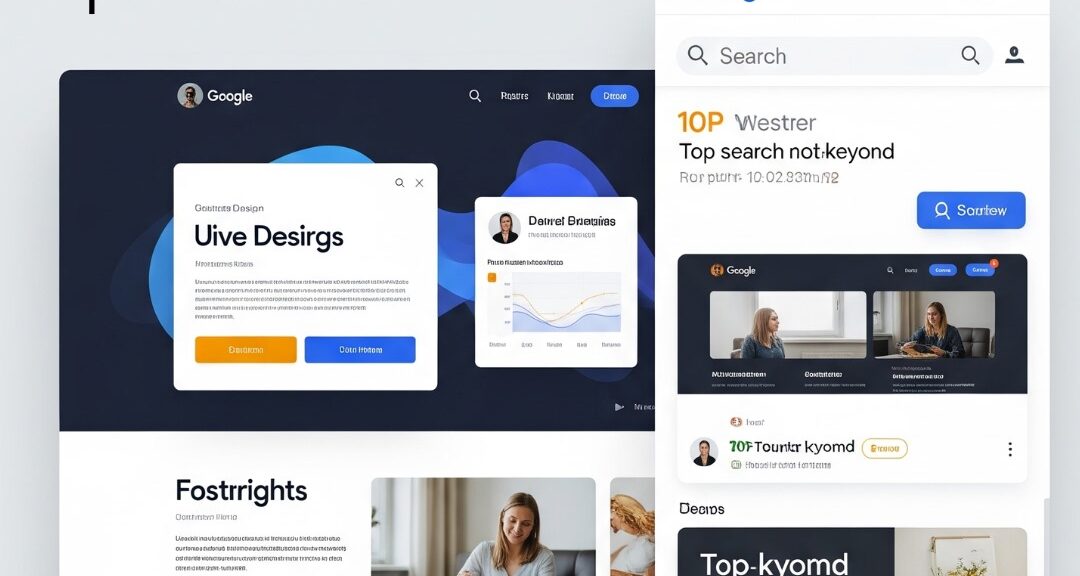
Just because you have a great website in a digital-centric world does not mean you will always get traffic to your site. And that is where web design and search engine optimization (SEO) come into play. These two elements go hand-in-hand to guarantee that online presence is eye-catching and, concurrently, searchable.
Web design, in turn, is more about creating an aesthetic and interesting interface that appeals to visitors, whereas search engine optimization is about making your website visible on Google and other search engines. The higher visibility will, in turn, attract organic traffic and potential customers. Together, they create a synergy that, if exploited, can lift your business above the competition.
The guide will explore the critical essentials of web design and SEO-going deeper into the nitty-gritty of creating websites that are good-looking as well as getting high search rank. With this guide, whether you’re a novice or a marketer with some experience, you’ll learn strategies, best practices, and practical tips for nailing both web design and SEO to help achieve your brand’s success.
What is Web Design and Why It Matters
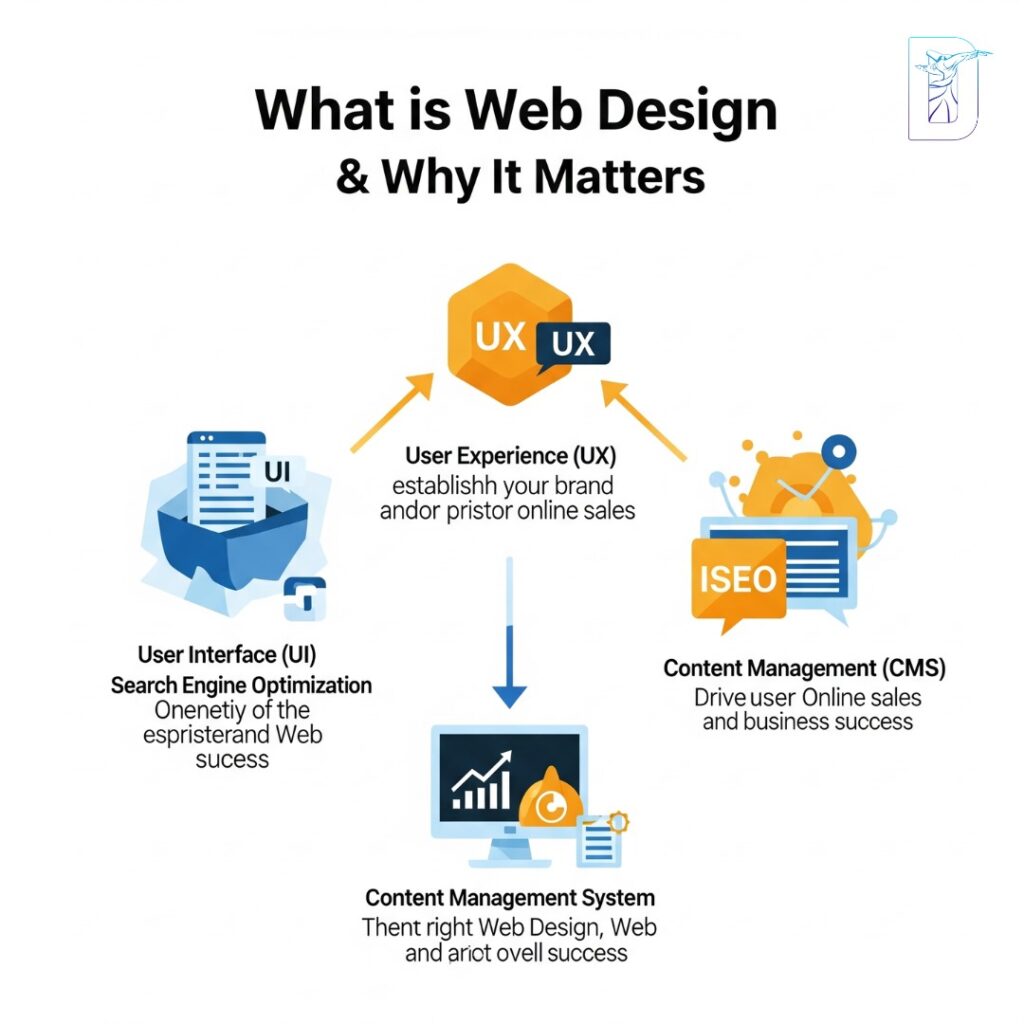
A web design may be defined as the procedures of planning, conceptualizing, and arranging the content and visual elements of a website. That encompasses everything from layouts, color schemes, typography, and navigation menus to all possible interactive features, such as buttons, forms, and animations. In other words, web design acts as a bridge between your brand and audience in the digital space through an amalgamation of aesthetics and usability to bring life to an engaging online presence.
Why is Web Design Important?
1. First Impressions Count
The site on which the visitors very usually visit is your company; for all, such online clients would have to build up an opinion about the website, according to studies, within the first 50 milliseconds—yes, milliseconds! Just as fast, a credible-looking, professional, easy-to-maneuver website earns instant credibility and trust. In contrast, a messy, old-fashioned design drives visitors away even if the product or service is excellent.
2. User Experience (UX) is Key
Effective web design must keep usability (UX) at the top of the pyramid. It enables a visitor to access a particular site quickly and do whatever is desired on the site, like buying or subscribing to a newsletter.The navigation is user-friendly, has crystal clear informative CTAs, is faster loading, and makes the entire site consumable on a mobile device. This frictionless experience tends to reduce frustration and bouncing, allowing the user to linger on the site for longer and engage more deeply in its content.
3. Brand Identity and Consistency
Websites are digital shop fronts where their host should represent everything that is personality, value and professionalism of the brand itself. Consistency in colors, fonts, logos, images all help to cement the recognition of the brand itself and draw a thick line of differentiation from competitors. Thus a well-designed website defines your brand story and connects with your audience at an emotional level which is essential to glee patronage and trust.
4. Boosting Conversion Rates
Beauty is not just in the eyes of the beholder; the art of website designing serves to shepherd visitors into fulfillment of certain business goals. Such activities could involve making a purchase, booking a consultation, filling out a contact form, or signing up for a newsletter. Other conversion factors for a visitor are strategically placed CTAs, easy-to-use forms, and simplified checkout processes. Of course, effective design reduces distractions and thus enhances the user journey towards conversion.
5. Balancing Creativity with Functionality
Modern web design is strikingly a balanced test between creative excellence and functional application. It is possible to lure users using eye-catching graphics and animations, provided that they do not compromise the speed or usability of the site. Accessibility for people with disabilities and, therefore, a more far-reaching audience, legal compliance, it aims to make a responsive, fast-loading site that looks good on any device-desktop, tablets, and smartphones.
Understanding Search Engine Optimisation (SEO)
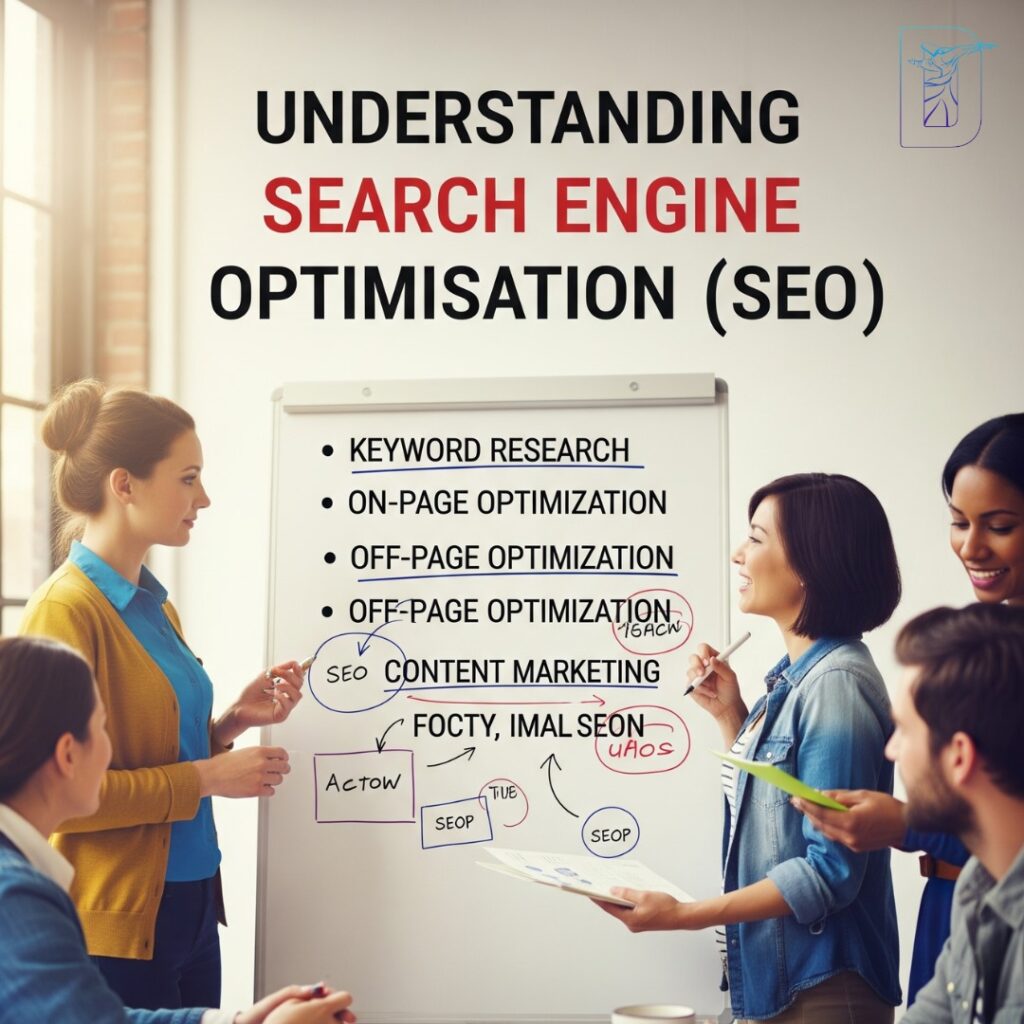
SEO is a commonly used term that refers to search engine optimization, which denotes processes that enhance the visibility of a website on search engine results pages, be it Google, Yahoo, or Bing.Basically, correlating ways to enhance the relevance of a given site and establish its authority for certain search queries will result in increased organic traffic, which is traffic that pays nothing for downward site connections.
SEO is a combination of skills: technical way of looking at things, creative insight, and analytical rationale. This ensures that the search engines will get clues about what your content is about and will value it enough to bring your name to the very top of the list when users search for related topics.
Core Components of SEO
1. On-Page SEO
Here are factors that can be controlled directly from your website for ranking and relevance: on-page SEO, while off-page SEO deals more with factors controllable from afar. Starting with the on-page elements, these are:
- SEO-Optimized Content: This means producing highly engaging and resourceful content that talks about the intent, needs, and desires of the user while including relevant keywords1.
- Title Tags and Meta Description: An enticing title and meta description will make the website clickable in the results when it includes the user’s target keyword.
- Heading: H1, H2, H3: Properly labeled headings provide content flow for readers and for search engines, give an outline of what is important to the page’s content.
- Keyword Usage: Inserting keywords which are related to your primary and secondary keywords in a way that appears natural.
- Image Optimization: Use proper descriptive alt text and file names, and compress images in order to improve loading speed.
2. Off-Page SEO
The practice of off-page SEO builds your site’s reputation and authority across the Internet.For you to achieve this, one of the strategies includes:
- Backlinks: Each link to your content from an authoritative website serves as evidence to search engines for trust in the content’s authenticity and value.
- Social Signals: Through improving visibility on SERPs, with shares, likes, and mentions on social media, they somewhat impact SEO.
- Guest blogging and influencer outreach: Consulting industry experts for collaboration and backlinking.
3. Technical SEO
On-page SEO focuses on improving the inner workings of your website to help it get crawled, indexed, and ranked by search engines efficiently. Some prime examples of this include:
- Site speed: The faster the website, the better the user experience, and the more it is favored by search engines.
- Responsive Mobile Site: Due to the exponentially growing trend of mobile browsing, Google has activated its mobile-first indexing, where your mobile site will be given the foremost importance when it comes to ranking.
- Structured Data: These help search engines understand your content better in context and find it easier to apply rich snippets to their search results.
- XML Sitemaps and Robots.txt: Introduce directions to search engines regarding which lame-ass pages to crawl and index.
- Secure HTTPS Protocol: This secures user data and builds trust and is also a ranking factor.
Why is SEO Crucial?
1. Increased Visibility
Ranking on the first page of results significantly improves the odds that users will click onto your site. Most users hardly ever scroll past the first page; thus, a top presence is needed for quality traffic.
2. Enhanced Credibility and Trust
Websites that perform better generally create a more authoritative and trustworthy image in the consideration of users. Good SEO gives signals to your audience that your site is a valid source of information or services.
3. Cost-Effectiveness
Contrarily to paid ads, the organic SEO effort can get you sustainable traffic with no ongoing payment for each click or impression. It requires upfront investment in content generation and optimization, but the long-term traffic and ROI usually surpass that of the paid campaign.
4. Better User Experience
SEO enhances user experience by making navigation easy, speedier, and mobile-friendly. It positively affects search engine rankings and enhances user satisfaction and return rates.
How Web Design and Search Engine Optimisation Work Together
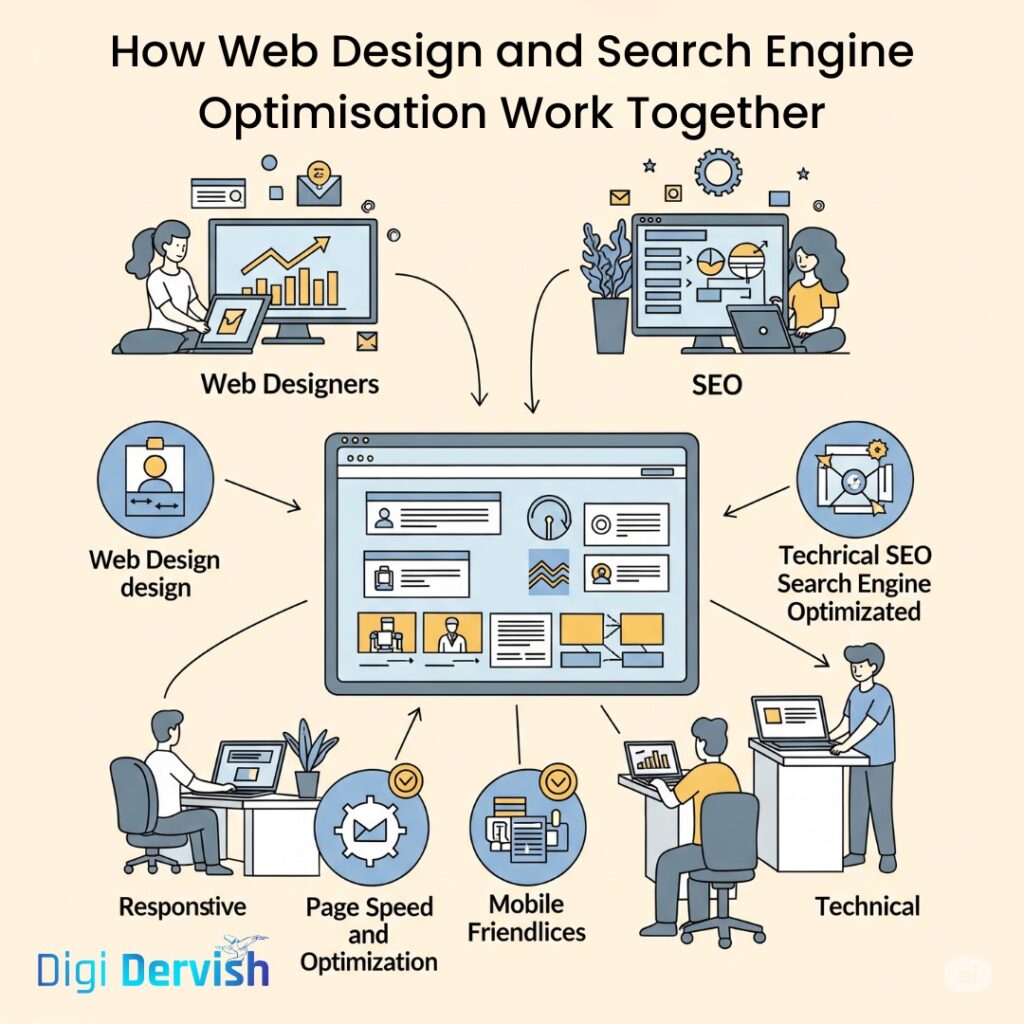
This is one of the most important things that you should do very early in your website project. Once web design and search engine optimisation (SEO) are married together, they create an outstanding look not only in terms of your site’s appearance but also in getting it very discoverable by search engines. When web design and SEO are pulled, it gives a super experience, which can help your visitors and improve search rankings.
Enhancing User Engagement Signals
An efficient website makes good user engagement, and search engines interpret that as quality content and relevance. For example:
- Lower Bounce Rates: When a visitor enters a website and finds it easy to navigate and pleasant, they are less likely to leave the site promptly. Therefore, a low bounce rate is indicative that users are finding what they are looking for, getting the search engines, like Google, to rank your site higher.
- Longer Session Durations: Engaging design, clear calls to action, easy access to content, and interactive elements keep users exploring your site longer-another positive ranking signal.
- More Artificial Artificial Intelligence: Effective design leads the users naturally to key actions-like purchases or filling in contact forms-thus proving value and purpose of site further.
SEO-Friendly Design Elements
Certain design practices directly contribute to better SEO outcomes:
- Clean, Intuitive Navigation: This type of menu structure can be effective in directing both users and search engines to the most important pages directly. Neatly structured navigation also makes for boon crawlability, enabling search engines to index your site smoothly.
- Speedy Load Time: Here, your design decisions can include optimizing images, reducing heavy scripts, and ensuring clean code-in-all-improves page speed, which happens to be one of the major SEO ranking factors. Also, it has been found that better sites reduce user drop-offs.
- Optimized URL Structure: Design simple, descriptive, and keyword-filled URLs through which users and search engines find the pages easier to understand.
- Consistent Header Tag Usage: With the right design of content hierarchy (H1, H2, H3 tags), search engines can interpret well the structure and relevance of your content.
Responsive and Mobile-First Design
As mobile devices account for over half of global internet access, responsive web design has become essential and not just an option. With the advent of mobile-first indexing by Google, the mobile version of your site is used mostly for determining rankings. Key aspects include:
- Adaptivity: Websites should conform layouts, images, and fonts for any screen size, without losing usability.
- Touch-Friendly Elements: Tapping buttons and links should be made easier on smaller screens to promote user interaction.
- Avoiding Intrusive Interstitials: Nobody likes pop-ups that cover content, and neither does Google in punishing sites using intrusive ads.
Synergy for Maximum Impact
When design for the web meets modules for SEO:
- The search engines crawl, understand, and rank your website.
- The users are satisfied with seamless, fast, and beautiful experiences.
- Your brand is given credibility, visibility, and engagement metrics that in turn boost its SEO.
To sum it all up, an excellent balance of design and SEO on websites will shine in any crowded market, procure good traffic, and turn visitors into faithful customers.
Key Elements of Effective Website Designing for SEO
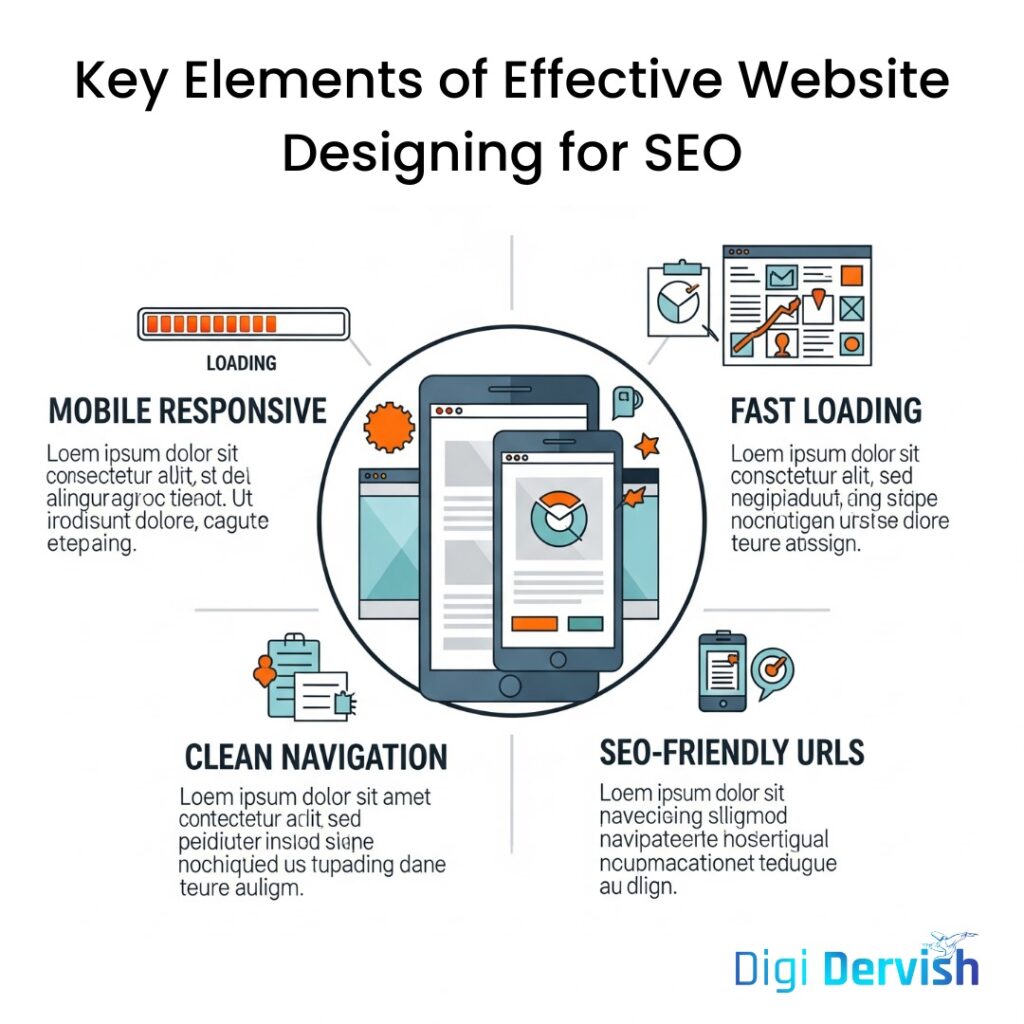
Web design refers to the action taken in making a website that does not only look fabulous but also centers on the functionality aspect of how the site performs in search engines. Thus, here are the must-have ingredients in the website designing for SEO that every business must give attention to:
1. Clean, Intuitive Navigation
- Its Significance: Navigation serves as a road map, making travel for both visitors and search engine crawlers. Clean and well-defined menu structure helps users quickly find the information they are looking for which reduces frustration and bouncing.
Best Practices :
- Give clear and descriptive headings of menu items.
- Limit menu options so as not to overwhelm.
- Make breadcrumb navigation for users to understand where they are in your site.
- Add a site-map making it more crawlable and indexable by the search engines.
- Benefit: Easier navigation increases the crawlability of a site, hence accurately reflecting pages within it in search engines’ indices, increasing your overall SEO performance.
2. Fast Loading Speed
Website speed is directly correlated with user-experience. By simply waiting a few seconds for a page to load, a visitor would become highly frustrated and, more often than not, abandon the website.
Speed Enhancement Techniques:
- Compress images without losing pixel quality.
- Reduce heavy using script and plug-in.
- Advocate browser caching and CDNs.
- Follow clean and efficient coding.
- benefit: Speed has been included in the Google ranking algorithm. A website that loads faster compared to its competitors would, more often than not, be ranked higher, with lower bounce rate.
3. Mobile Responsiveness
- Why It Matters: More than half of all Internet traffic around the world comes from mobile devices and therefore, the website should render the best possible experience across smartphones and tablets.
Responsive Design Tips:
- Use a fluid grid layout that will resize according to varying screen sizes.
- Make sure text can be read without needing to zoom in.
- Make buttons and links easy to tap on smaller screens.
- Any pop-ups or interstitials should be avoided, as they interrupt mobile browsing.
- Benefit: Google uses a mobile-first index, which means it checks out your site’s mobile version for majority ranking evaluation. A mobile-friendly design is fundamental to keeping and increasing search rankings.
4. SEO-Friendly URL Structure
- Want To Know Why: By the time any search engine or user glances at URLs, they are now one of the first things they see. A clean and descriptive URL gives a clear context of what the page is about.
Optimizing:
- Short and simple should be maintained in the URL’s phrase.
- Include each relevant keyword in a conversational tone.
- Words should be separated by hyphens (note: underscores should be avoided).
- Dynamic parameters or any other kinds of excessive numbers or symbols should be avoided.
- Advantage: Clear URL structure helps users and search engines to better understand content hierarchy in turn enhancing page relevance in search results.
5. Clear Call-to-Actions (CTAs)
- What exactly does this mean: CTAs would mean something to visitors when it directs them to the site for a specific purpose, whether for making a purchase, signing up for a newsletter, or contacting your business.
Guidelines for Designing CTAs:
- Use contrasting colors to make the CTAs pop out.
- Place them right at the top of the fold, but also seamlessly along the page.
- Concise and action-oriented copy eg ‘Get Started’, ‘Subscribe Now’.
- Even check A/B testing using different placements and wording to improve conversions.
- Benefit: These indications do not mean CTAs would be listed in the search engines. It improves user engagement and conversions, which are among the behavioral signals that keep the search engine up in the SEO rankings.
Additional Elements to Consider
- Consistent Branding: Maintain uniform fonts, colors, and imagery to strengthen brand identity and trust.
- Accessible Design: Ensure your site is usable by people with disabilities by following accessibility guidelines (e.g., alt text for images, keyboard navigation).
- Structured Data Markup: Implement schema to help search engines understand your content and enhance search listings with rich snippets.
Technical SEO Considerations in Web Design
Your website’s technical foundation directly affects its SEO performance:
- XML Sitemaps: Help search engines index your pages efficiently.
- Robots.txt: Controls what parts of your site are crawlable.
- Structured Data Markup: Enables rich snippets in search results.
- HTTPS Security: Secure sites rank better and gain user trust.
- Canonical Tags: Prevent duplicate content issues.
Content Strategy: The Bridge Between Web Design and SEO
Content is king — it connects your website design with your SEO efforts.
- Use keyword research to create relevant, valuable content.
- Structure content with headings, bullet points, and visuals for readability.
- Optimize images with alt text for SEO.
- Include internal links to related pages on your site, improving navigation and authority.
Mobile-Friendly Design and SEO
Google uses mobile-first indexing, meaning it predominantly uses the mobile version of the content for ranking and indexing.
- Responsive design adapts layout for all devices.
- Touch-friendly buttons and fast loading enhance mobile user experience.
- Avoid intrusive interstitials (pop-ups) on mobile.
Common Web Design Mistakes That Hurt SEO
- Ignoring mobile optimization
- Using heavy images without compression
- Overusing Flash or complex scripts
- Poor navigation and internal linking
- Duplicate content and missing meta tags
Tools and Resources for Web Design and SEO
- Google Analytics & Search Console: Track performance and fix SEO issues.
- PageSpeed Insights: Analyze and improve website speed.
- Yoast SEO (for WordPress): Simplifies on-page SEO.
- Screaming Frog SEO Spider: Crawl site for technical audits.
- Canva & Adobe XD: Design tools for website graphics.
Final Thoughts: Mastering Web Design and Search Engine Optimisation
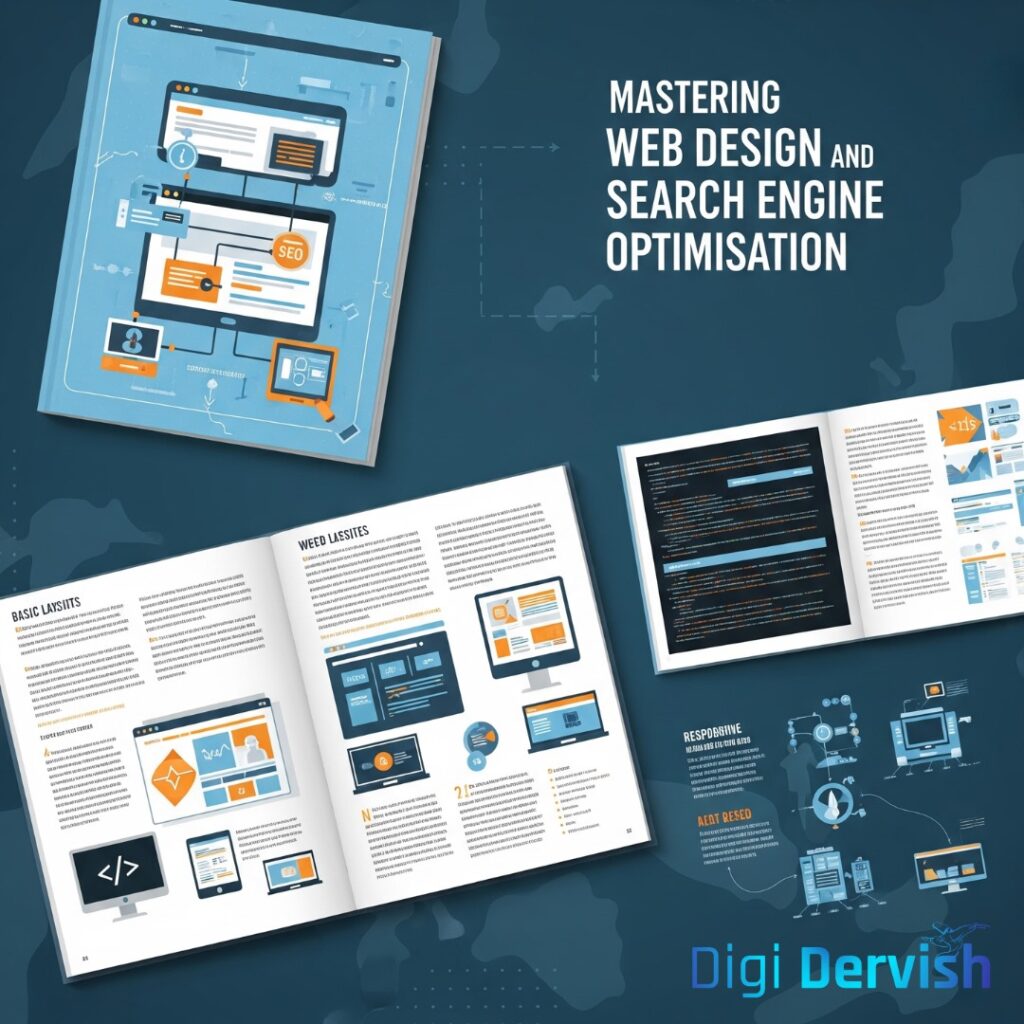
Combining expert web design and search engine optimisation is essential for building successful websites that attract, engage, and convert visitors. Prioritize user experience, speed, and mobile responsiveness while aligning your content and technical SEO strategies.
Ready to transform your website and boost your online visibility? Partner with Digi Dervish, your trusted digital marketing experts. We specialize in creating SEO-optimized, beautifully designed websites that deliver results. Contact us today to start your journey toward digital success!



